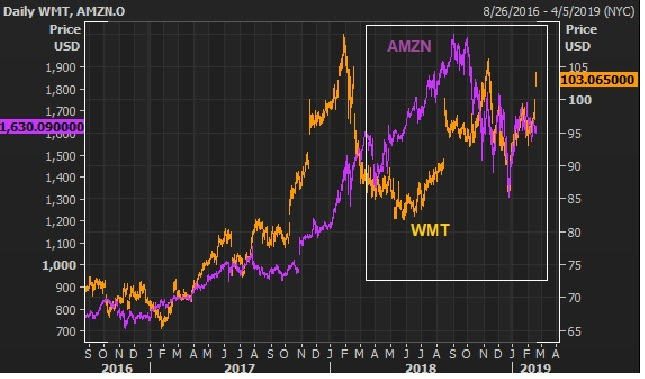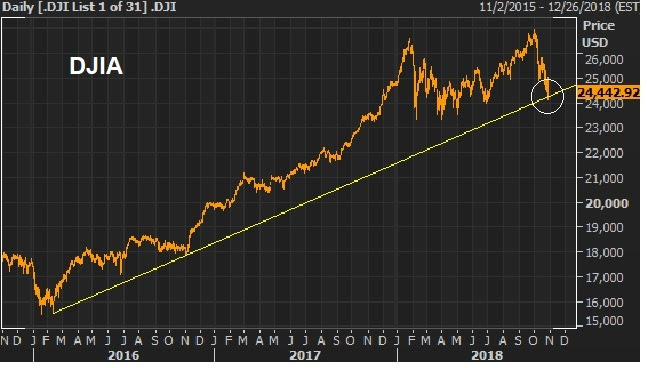|
|
|
June 26, 5:00 pm EST While the media continues to be stuck on the global jawboning about trade. We’ve been talking about the continued domestic “leveling of the playing field.” We’ve seen the verbal and Twitter shots taken by Trump at the tech giants since he’s been in office. And the threats have slowly been materializing as policy. Late last year, we talked about the repeal of the Net Neutrality rule. And now we have the Supreme Court ruling that subjects internet sales to state tax. Before you know it, the tech giants (Facebook, Amazon, Netflix, Google …) may actually be held to a similar standard that their “old economy” competitors are held to. They may have to pay for real estate (i.e. bandwidth). They may be liable for content on their site, regardless of who created it. And they may be scrutinized more heavily for anti-competitive practices. That means, the costs may go UP for these companies. And the cost may go UP for consumers. But a more balanced and stable economy and society may come with it. So, the balance of power is shifting, just as people were becoming convinced that Amazon was taking over the world. As we’ve discussed, if the market starts pricing OUT the prospects of Amazon becoming a monopoly, then the jaws may be closing on this chart … |
 |
|
Join our Billionaire’s Portfolio today to get your portfolio in line with the most influential investors in the world, and hear more of my actionable political, economic and market analysis. Click her
|
January 8, 4:00 pm EST
Heading into the end of last year, we talked about the regulatory scrutiny starting to emerge toward the big tech giants (Facebook, Apple, Amazon, Netflix, Google… Tesla, Uber, Airbnb…) – and the risk that the very hot run they’ve had “could be coming to an end.”
These companies have benefited from a formula of favor from the Obama administration, which included regulatory advantages and outright government funding (in the case of Tesla). That created a “winner takes all” environment where this group of startups and loss-laden ventures, some with questionable business models, were able to amass war chests of capital, sidestep enduring laws, and operate without the constraints of liabilities (including taxes, in some cases) that burdened its competitors.
With the screws now beginning to tighten, under a new administration, and with the tailwinds of economic stimulus heading into the new year, I thought 2018 may be the year of the bounce back in the industries that have been crushed by the internet giants.
Among the worst hit, and left for dead industry, has been retail.
Last year, retail stocks looked a lot like energy did in the middle of 2016. If you were an energy company and survived the crash in oil prices to see it double off of the bottom, you were looking at a massive rebound. Some of those stocks have gone up three-fold, five-fold, even ten-fold in the past 18 months.
Similarly, if you’re a big-brand bricks and mortar retailer, and you’ve survived the collapse in global demand–and a decade long stagnation in the global economy–to see prospects of a 4% growth economy on the horizon, there’s a clear asymmetry in the upside versus the downside in these stocks. These are stocks that can have magnificent comebacks.
Remember, back in November we talked about the comeback underway in Wal-Mart and the steps it has made to challenge Amazon (you can see that again, here). In support of that thesis, the earnings numbers that came in for retail for the third quarter were strong. And now we’re getting a glimpse of what the fourth quarter will look like, as several retailers this morning reported strong holiday sales, and upped guidance on the fourth quarter.
Just flipping through a number of charts on retail stocks, the bottom appears to be in on retail – with many bottoming out in the September-November period last year. Since then, to name a few, Ralph Lauren is up 26%, Michael Kors is up 36%, Under Armour is up 42% and Footlocker is up 64%. The survivors have been comebacks as they’ve weathered the storm and now are blending their physical presence with an online presence.
By the time you get a ETF designed to bet against the survival of bricks and mortar retail, the bottom is probably in. That ETF, the Decline Of The Retail Store (EMTY), launched on November 17 and has gone straight down since.
For help building a high potential portfolio, follow me in our Billionaire’s Portfolio, where you look over my shoulder as I follow the world’s best investors into their best stocks. Our portfolio of highest conviction, billionaire-owned stocks is up close to 50% over the past two years. And 25% of our portfolio is in commodities stocks. You can join me here and get positioned for a big 2018.
November 23, 2017, 7:00 pm EST
 Yesterday we talked about the comeback underway in Wal-Mart and the steps it has made to challenge Amazon, and to challenge the idea that Amazon will crush everyone.
Yesterday we talked about the comeback underway in Wal-Mart and the steps it has made to challenge Amazon, and to challenge the idea that Amazon will crush everyone.
It’s beginning to look like the “decline of the retail store” may have bottomed too.
And it so happens that it may have bottomed precisely when a new ETF launched to capitalize on that story. ProShares launched it yesterday, and that is the name of it –ProShares Decline Of The Retail Store ETF. It gives you short exposure to bricks and mortar retailers.
It’s off to a bad start–down 3% in the first day of trading.
For retail, the week started with a big earnings beat for Advance Auto Parts (the stock was up as much as 20% on Tuesday). Then it was Wal-Mart. And today we had earnings beats in Foot Locker and Abercrombie and Fitch.
With this, while the Dow and S&P 500 were down on the day, the small-cap (Russell 2000) was up nicely. Here’s why …

As bad as retail has been, the energy sector remains the worst performing for the year–down 11% year-to-date as a sector and the only sector in the red. This, as oil has reversed from down 22% on the year, to up around 5%, with a very bullish outlook.

Join our Billionaire’s Portfolio today to get your portfolio in line with the most influential investors in the world, and hear more of my actionable political, economic and market analysis. Click here to learn more.





